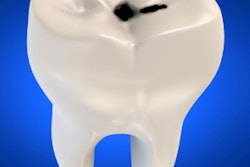
Sealants are an inexpensive and effective item in the dentist's toolkit, but there is room for improvement. While dentists have the right attitude about them, questions about their knowledge of how to use them arose in a new study published in the Journal of the American Dental Association (August 2014, Vol. 145:8, pp. 849-855).
"Most of the study participants had adopted the use of dental sealants into their clinical practices as a preventative measure and had high levels of positive attitudes about using dental sealants," wrote the researchers from the Nova Southeastern University College of Dental Medicine in Fort Lauderdale, FL. "Despite this, their levels of evidence-based clinical knowledge about the appropriate use of sealants were low."
This was unexpected, given the simplicity of the treatment and its effectiveness in treating caries, which affect as many as 14% of children between the ages of 3 and 9. Sealants could be used more frequently to treat caries in children. There are several reasons why they aren't used as often as they could be.
"These factors included a lack of certainty about the effectiveness of the sealant, concerns about accurate tooth selection, fear of sealing in caries, poor retention rates, difficulty managing the treatment of young children, limited insurance coverage or parents' unwillingness to pay for sealant placement, and frequent need for maintenance or replacement," the authors wrote.
The ADA encourages the use of sealants, especially for children, and urges patients to ask their dentists about them.
"The likelihood of developing pit and fissure decay begins early in life, so children and teenagers are obvious candidates. But adults can benefit from sealants as well," the organization explained on its oral health website, MouthHealthy.org.
Florida, in particular, has abysmal rates of sealant placement and was given a D grade by the Pew Center in a 2013 report because of the lack of access that children have to them in the state. Consequently, the researchers were motivated to evaluate dentists' opinions about them.
Their cross-sectional study included 163 general and pediatric dentists who attended the 2013 Florida National Dental Convention. The researchers gathered information about their sex, race, and type of dentist and asked how long it had been since they had completed their predoctoral dental program, was their postdoctoral program in the U.S., was the sealant training they received in a predoctoral curriculum, if they took Medicaid patients, and whether they took new pediatric patients who covered by Medicaid.
The vast majority of the participants were general dentists (92%), completed their postdoctoral dental education in the U.S. (91%), and had dental sealant training as part of their dental curricula (91%). Their main concern (42%) about sealants was the possibility of sealing in decay, while 41% noted that it was a technique-sensitive procedure. Interestingly, 25% said there was a lack of research evidence as a concern. "Dental sealants are a proven, effective preventative measure for caries," the study authors wrote in their discussion.
The ADA noted in a 2011 study that dentists were not sealing noncavitated lesions, despite the organization urging them to do so. Tellingly, "only 8% (13 of 163) of participants correctly identified that visual examination of the tooth after cleaning and drying it was the only appropriate technique for diagnosing early, noncavitated carious lesions" in the current study, the authors wrote. Only 25% stated correctly that they would apply sealants without mechanically preparing the enamel.
In their analysis, the researchers found that dentists who accepted new pediatric patients enrolled in Medicaid had better evidence-based clinical knowledge of sealants, but only 19% of the respondents accepted Medicaid.
Based on the responses they received, the researchers had suggestions for U.S. dental schools. "We recommend that dental schools update their own guidelines to match those of the ADA and integrate them into the predoctoral dental curriculum as part of sealant education courses or already existing modules," they wrote.



















